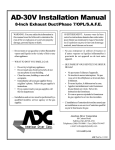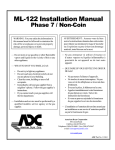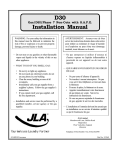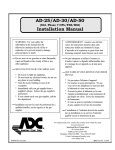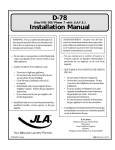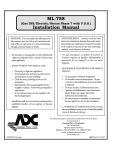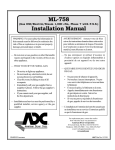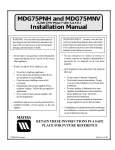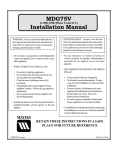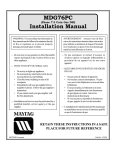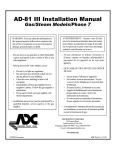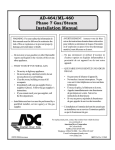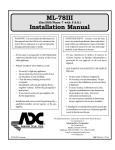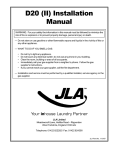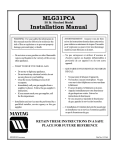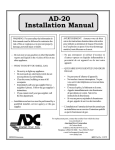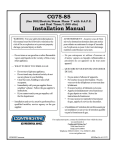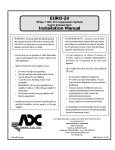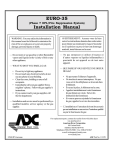Download American Dryer Corp. Gas DSI/HSI/Electric/Steam/Phase 7 with S.A.F.E. D-40 Installation manual
Transcript
D50 Installation Manual (Gas/DSI/HSI/Electric/Steam/Phase 7 and Dual Timer with S.A.F.E.) WARNING: For your safety the information in this manual must be followed to minimize the risk of fire or explosion or to prevent property damage, personal injury or death. AVERTISSEMENT: Assurez-vous de bien suivre les instructions données dans cette notice pour réduire au minimum le risque d’incendie ou d’explosion ou pour éviter tout dommage matériel, toute blessure ou la mort. — Do not store or use gasoline or other flammable vapors and liquids in the vicinity of this or any other appliance. — Ne pas entreposer ni utiliser d’essence ni d’autres vapeurs ou liquides inflammables à proximité de cet appareil ou de tout autre appareil. — WHAT TO DO IF YOU SMELL GAS: • Do not try to light any appliance. • Do not touch any electrical switch; do not use any phone in your building. • Clear the room, building or area of all occupants. • Immediately call your gas supplier from a neighbor’s phone. Follow the gas supplier’s instructions. • If you cannot reach your gas supplier, call the fire department. — Installation and service must be performed by a qualified installer, service agency or the gas supplier. — QUE FAIRE SI VOUS SENTEZ UNE ODEUR DE GAZ: • Ne pas tenter d’allumer d’appareils. • Ne touchez à aucun interrupteur. Ne pas vous servir des téléphones se trouvant dans le bâtiment. • Évacuez la pièce, le bâtiment ou la zone. • Appelez immédiatement votre fournisseur de gaz depuis un voisin. Suivez les instructions du fournisseur. • Si vous ne pouvez rejoindre le fournisseur de gaz, appelez le service des incendies. — L’installation et l’entretien doivent être assurés par un installateur ou un service d’entretien qualifié ou par le fournisseur de gaz. JLA Limited Meadowcroft Lane, Halifax Road Ripponden West Yorkshire, England HX6 4AJ Telephone: 01422 822282 / Fax: 01422 824390 032102JEV/mcronan ADC Part No. 113371 Retain This Manual In A Safe Place For Future Reference This product embodies advanced concepts in engineering, design, and safety. If this product is properly maintained, it will provide many years of safe, efficient, and trouble free operation. ONLY qualified technicians should service this equipment. OBSERVE ALL SAFETY PRECAUTIONS displayed on the equipment or specified in the installation manual included with the dryer. The following “FOR YOUR SAFETY” caution must be posted near the dryer in a prominent location. FOR YOUR SAFETY POUR VOTRE SÉCURITÉ Do not store or use gasoline or other flammable vapors and liquids in the vicinity of this or any other appliance. Ne pas entreposer ni utiliser d’essence ni d’autres vapeurs ou liquides inflammables à proximité de cet appareil ou de tout autre appareil. We have tried to make this manual as complete as possible and hope you will find it useful. Manufacturer reserves the right to make changes from time to time, without notice or obligation, in prices, specifications, colors, and material, and to change or discontinue models. The illustrations included in this manual may not depict your particular dryer exactly. Important For your convenience, log the following information: D50 Phase 7 DATE OF PURCHASE ________________________________ MODEL NO. __________________________________________ DISTRIBUTOR’S NAME ____________________________________________________________________________________ Serial Number(s) ________________________________________________________________________________________ ________________________________________________________________________________________ ________________________________________________________________________________________ Replacement parts can be obtained from your distributor or JLA. When ordering replacement parts from JLA, you can FAX your order to JLA at 01422 824390 or telephone your order directly to the JLA Parts Department at 01422 822282. Please specify the dryer model number and serial number in addition to the description and part number, so that your order is processed accurately and promptly. “IMPORTANT NOTE TO PURCHASER” Information must be obtained from your local gas supplier on the instructions to be followed if the user smells gas. These instructions must be posted in a prominent location near the dryer. IMPORTANT YOU MUST DISCONNECT AND LOCKOUT THE ELECTRIC SUPPLYAND THE GAS SUPPLY OR THE STEAM SUPPLY BEFORE ANY COVERS OR GUARDS ARE REMOVED FROM THE MACHINE TO ALLOW ACCESS FOR CLEANING, ADJUSTING, INSTALLATION, OR TESTING OF ANY EQUIPMENT PER OSHA (Occupational Safety and Health Administration) STANDARDS. “Caution: Label all wires prior to disconnection when servicing controls. Wiring errors can cause improper operation.” «Attention: Lor des opérations d’entretien des commandes étiqueter tous fils avant de les déconnecter. Toute erreur de câblage peut étre une source de danger et de panne.» CAUTION DRYERS SHOULD NEVER BE LEFT UNATTENDED WHILE IN OPERATION. WARNING CHILDREN SHOULD NOT BE ALLOWED TO PLAY ON OR NEAR THE DRYER(S). CHILDREN SHOULD BE SUPERVISED IF NEAR DRYERS IN OPERATION. FOR YOUR SAFETY DO NOT DRY MOP HEADS IN THE DRYER. DO NOT USE DRYER IN THE PRESENCE OF DRY CLEANING FUMES. WARNING UNDER NO CIRCUMSTANCES should the dryer door switches, lint drawer switch, or heat safety circuit, ever be disabled. WARNING The dryer must never be operated with any of the back guards, outer tops, or service panels removed. PERSONAL INJURY or FIRE COULD RESULT. WARNING DRYER MUST NEVER BE OPERATED WITHOUT THE LINT FILTER/SCREEN IN PLACE, EVEN IF AN EXTERNAL LINT COLLECTION SYSTEM IS USED. IMPORTANT PLEASE OBSERVE ALL SAFETY PRECAUTIONS displayed on the equipment and/or specified in the installation manual included with the dryer. Dryer must not be installed or stored in an area where it will be exposed to water or weather. The wiring diagram for the dryer is located in the front electrical control box area. IMPORTANT Dryer must be installed in a location/environment, which the ambient temperature remains between 40° F (4.44° C) and 130° F (54.44° C). Table of Contents SECTION I IMPORTANT INFORMATION ............................................................................... 3 A. Receiving and Handling ............................................................................................................... 3 B. Safety Precautions ...................................................................................................................... 4 SECTION II SPECIFICATIONS ..................................................................................................... 6 A. Specifications ............................................................................................................................. 6 SECTION III INSTALLATION PROCEDURES ........................................................................... 8 A. B. C. D. E. F. G. H. I. J. K. L. Unpacking/Setting Up ................................................................................................................. 8 Location Requirements ............................................................................................................... 9 Dryer Enclosure Requirements .................................................................................................. 10 Fresh Air Supply Requirements ................................................................................................. 11 Exhaust Requirements ............................................................................................................... 12 Electrical Information ................................................................................................................ 18 Gas Information ........................................................................................................................ 24 Steam Information .................................................................................................................... 28 Preparation For Operation/Start-Up ......................................................................................... 33 Preoperational Tests ................................................................................................................. 34 Preoperational Instructions ........................................................................................................ 35 Shutdown Instructions ............................................................................................................... 37 SECTION IV SERVICE/PARTS INFORMATION ...................................................................... 38 A. Service ..................................................................................................................................... 38 B. Parts ........................................................................................................................................ 38 SECTION V WARRANTY INFORMATION............................................................................... 39 A. Returning Warranty Cards ......................................................................................................... 39 B. Warranty .................................................................................................................................. 39 SECTION VI ROUTINE MAINTENANCE .................................................................................. 40 A. B. C. D. Cleaning ................................................................................................................................... 40 Adjustments ............................................................................................................................. 41 Lubrication ............................................................................................................................... 41 Lint Drawer Removal ................................................................................................................ 42 SECTION VII DATA LABEL LOCATION/INFORMATION ...................................................... 43 A. Data Label ............................................................................................................................... 43 SECTION VIII REVERSING TIMER SPIN/DWELL ADJUSTMENTS..................................... 45 SECTION IX NON-COIN SENSOR ACTIVATED FIRE EXTINGUISHING (S.A.F.E.) SYSTEM ..................................................... 46 Installation ...................................................................................................................................... 47 Sensor Activated Fire Extinguishing (S.A.F.E.) System Theory of Operation .................................... 50 Non-Coin System Reset ................................................................................................................. 50 Non-Coin S.A.F.E. System Check Procedure ................................................................................. 50 Coin Disabled Sensor Activated Fire Extinguishing (S.A.F.E.) System .............................................. 51 Coin S.A.F.E. System Diagnostic Messages .................................................................................... 51 Coin System Reset ......................................................................................................................... 51 Sensor Activated Fire Extinguishing (S.A.F.E.) System Parts Break Down ....................................... 52 SECTION I IMPORTANT INFORMATION A. RECEIVING AND HANDLING The dryer is shipped in a protective stretch wrap cover with protective cardboard corners and top cover (or optional box) as a means of preventing damage in transit. Upon delivery, the dryer and packaging, and wooden skid should be visually inspected for shipping damage. If any damage whatsoever is noticed, inspect further before delivering carrier leaves. Dryers damaged in shipment: 1. ALL dryers should be inspected upon receipt and before they are signed for. 2. If there is suspected damage or actual damage, the trucker’s receipt should be so noted. 3. If the dryer is damaged beyond repair, it should be refused. Those dryers, which were not damaged in a damaged shipment, should be accepted, but the number received and the number refused must be noted on the receipt. 4. If you determine that the dryer was damaged after the trucker has left your location, you should call the delivering carrier’s freight terminal immediately and file a claim. The freight company considers this concealed damage. This type of freight claim is very difficult to get paid and becomes extremely difficult when more than a day or two passes after the freight was delivered. It is your responsibility to file freight claims. Dryer/parts damaged in transit cannot be claimed under warranty. 5. Freight claims are the responsibility of the consignee, and ALL claims must be filed at the receiving end. Manufacturer assumes no responsibility for freight claims or damages. 6. If you need assistance in handling the situation, please contact JLA at 01422822282. IMPORTANT: The dryer must be transported and handled in an upright position at ALL times. 3 B. SAFETY PRECAUTIONS WARNING: For your safety, the information in this manual must be followed to minimize the risk of fire or explosion or to prevent property damage, personal injury, or loss of life. WARNING: The dryer must never be operated with any of the back guards, outer tops, or service panels removed. PERSONAL INJURY OR FIRE COULD RESULT. 1. DO NOT store or use gasoline or other flammable vapors and liquids in the vicinity of this or any other appliance. 2. Purchaser/user should consult the local gas supplier for proper instructions to be followed in the event the user smells gas. The instructions should be posted in a prominent location. 3. WHAT TO DO IF YOU SMELL GAS... a. DO NOT try to light any appliance. b. DO NOT touch any electrical switch. c. DO NOT use any phone in your building. d. Clear the room, building, or area of ALL occupants. e. Immediately call your gas supplier from a neighbor’s phone. Follow the gas supplier’s instructions. f. If you cannot reach your gas supplier, call the fire department. 4. Installation and service must be performed by a qualified installer, service agency, or gas supplier. 5. Dryer(s) must be exhausted to the outdoors. 6. Although JLA produces a very versatile dryer, there are some articles that, due to fabric composition or cleaning method, should not be dried in it. WARNING: Dry only water washed fabrics. DO NOT dry articles spotted or washed in dry cleaning solvents, a combustible detergent, or “all purpose” cleaner. EXPLOSION COULD RESULT. WARNING: DO NOT dry rags or articles coated or contaminated with gasoline, kerosene, oil, paint, or wax. EXPLOSION COULD RESULT. 4 WARNING: DO NOT dry mop heads. Contamination by wax or flammable solvents will create a fire hazard. WARNING: DO NOT use heat for drying articles that contain plastic, foam, sponge rubber, or similarly textured rubberlike materials. Drying in a heated basket (tumbler) may damage plastics or rubber and may be a fire hazard. 7. A program should be established for the inspection and cleaning of lint in the burner area, exhaust ductwork, and area around the back of the dryer. The frequency of inspection and cleaning can best be determined from experience at each location. WARNING: The collection of lint in the burner area and exhaust ductwork can create a potential fire hazard. 8. For personal safety, the dryer must be electrically grounded in accordance with local codes and/or the National Electrical Code ANSI/NFPA NO. 70-LATEST EDITION, or in Canada, the Canadian Electrical Codes Parts 1 & 2 CSA C22.1-1990 or LATEST EDITION. NOTE: Failure to do so will VOID THE WARRANTY. 9. UNDER NO CIRCUMSTANCES should the dryer door switches, lint drawer switch, or heat safety circuit, ever be disabled. WARNING: PERSONAL INJURY OR FIRE COULD RESULT. 10. This dryer is not to be used in the presence of dry cleaning solvents or fumes. 11. Remove articles from the dryer as soon as the drying cycle has been completed. WARNING: Articles left in the dryer after the drying and cooling cycles have been completed can create a fire hazard. 12. READ AND FOLLOW ALL CAUTION AND DIRECTION LABELS ATTACHED TO THE DRYER. 13. For safety, proper operation, and optimum performance, the dryer must not be operated with a load less than sixty-six percent (66%), 33 pounds (15 kg) of its rated capacity. WARNING: YOU MUST DISCONNECT AND LOCKOUT THE ELECTRIC SUPPLY AND THE GAS SUPPLY OR THE STEAM SUPPLY BEFORE ANY COVERS OR GUARDS ARE REMOVED FROM THE MACHINE TO ALLOW ACCESS FOR CLEANING, ADJUSTING, INSTALLATION, OR TESTING OF ANY EQUIPMENT PER OSHA (Occupational Safety and Health Administration) STANDARDS. IMPORTANT: Dryer must be installed in a location/environment, which the ambient temperature remains between 40° F (4.44° C) and 130° F (54.44° C). 5 SECTION II SPECIFICATIONS A. SPECIFICATIONS BASKET (TUMBLER) DIAMETER 32-3/4” 83.2 cm BASKET (TUMBLER) DEPTH 37-1/2” 95.3 cm BASKET (TUMBLER) MOTOR 3/4 hp* 0.560 kw DOOR OPENING (DIAMETER) 21-1/2” 54.61 cm BASKET (TUMBLER) VOLUME 18.3 cu ft 0.518 cu m DRYERS PER 20’/40’ CONTAINER 10/20 DRYERS PER 45’/48’ TRUCK 24/26 AIRFLOW Gas APPROX. WEIGHT (UNCRATED) 651 lbs 295.3 kg APPROX. WEIGHT (CRATED) 700 lbs 317.7 kg 150,000 btu/hr 37,800 kcal/hr HEAT INPUT 1/2” F.B.S.P.T.** OVEN SIZE kcal/hr kW Btu/hr 20 68,258 17,201 24 81,910 20,641 30 102,387 25,802 (60 HZ) (50 Hz) VOLTAGE AVAILABLE Steam**** 17.8 cmm 230-415v 1ø - 3ø 3, 4w 50/60 Hz INLET PIPE CONNECTION 120-460v 1ø - 3ø 3, 4w 50/60 Hz 309.9 kg APPROX. WEIGHT (UNCRATED) 683 lbs APPROX. WEIGHT (CRATED) 733 lbs 332.3 kg 0.75 cfh 0.02 cmh COMPRESSED AIR VOLUME AIR CONNECTION 1/8” F.N.P.T. STEAM CONSUMPTION 142 lbs/hr 64.4 kg/hr OPERATING PRESSURE 125 psi max 8.6 bar BOILER HP NORMAL LOAD 4.1 SUPPLY CONNECTION** RETURN CONNECTION 1” F.N.P.T. 1” F.N.P.T. Shaded areas are stated in metric equivalents * ** *** **** 50 Hz - 630 cfm 3/4” M.N.P.T. VOLTAGE AVAILABLE Electric*** 21 cmm 60 Hz - 750 cfm S.A.F.E. WATER CONNECTION 8/1/03 Reversing dryer available with 3-phase (3ø) motors standard (1/2 hp [0.37 kw] motors). Size of piping to dryer varies with installation conditions. Contact factory for assistance. Contact factory for information not listed, 3-phase (3ø) figures shown are for 3-wire service. Specify air-operated or electromechanical steam damper system. Air-operated steam damper system must be provided with clean, dry, and regulated 80 psi +/- 10 psi (5.51 bar +/- 0.69 bar) air supply. NOTE: Manufacturer reserves the right to make changes in specifications at any time without notice or obligation. 6 Specifications – Gas, Electric, and Steam NOTE: Manufacturer reserves the right to make changes in specifications at any time without notice or obligation. 7 SECTION III INSTALLATION PROCEDURES Installation should be performed by competent technicians in accordance with local and state codes. In the absence of these codes, the installation must conform to applicable American National Standards: ANSI Z223.1LATEST EDITION (National Fuel Gas Code) or ANSI/NFPA NO. 70-LATEST EDITION (National Electrical Code) or in Canada, the installation must conform to applicable Canadian Standards: CAN/CGA-B149.1-M91 (Natural Gas) or CAN/CGA-B149.2-M91 (Liquid Propane [L.P.] Gas) or LATEST EDITION (for General Installation and Gas Plumbing) or Canadian Electrical Codes Parts 1 & 2 CSA C22.1-1990 or LATEST EDITION (for Electrical Connections). A. UNPACKING/SETTING UP Remove protective shipping material (i.e., plastic wrap and optional shipping box) from dryer. IMPORTANT: Dryer must be transported and handled in an upright position at ALL times. The dryer can be moved to its final location while still attached to the skid or with the skid removed. To unskid the dryer, locate and remove the four (4) bolts securing the base of the dryer to the wooden skid. Two (2) are at the rear base (remove the back panel for access), and two (2) are located in the bottom of the lint chamber. To remove the two (2) bolts located in the lint chamber area, remove the lint drawer. With the skid removed, to make it easier to slide the dryer into its final position, slightly lower ALL four (4) leveling legs, so that the dryer will slide on the legs instead of the base frame. To increase bearing life and improve efficiency, the dryer should be tilted slightly to the rear. 1. Leveling Dryer The dryer is equipped with four (4) leveling legs, one (1) at each corner of the base. Two (2) are located at the rear of the dryer base, and two (2) are located in the lint chamber (coop). To increase bearing life and improve efficiency, the dryer should be tilted slightly to the rear. 8 B. LOCATION REQUIREMENTS Before installing the dryer, be sure the location conforms to local codes and ordinances. In the absence of such codes or ordinances the location must conform with the National Fuel Gas Code ANSI.Z223.1 LATEST EDITION, or in Canada, the installation must conform to applicable Canadian Standards: CAN/CGA-B149.1M91 (Natural Gas) or CAN/CGA-B149.2-M91 (L.P. Gas) or LATEST EDITION (for General Installation and Gas Plumbing). 1. The dryer must be installed on a sound level floor capable of supporting its weight. Carpeting must be removed from the floor area that the dryer is to rest on. IMPORTANT: “The dryer must be installed on noncombustible floors only.” 2. The dryer must not be installed or stored in an area where it will be exposed to water and/or weather. 3. The dryer is for use in noncombustible locations. 4. Provisions for adequate air supply must be provided as noted in this manual (refer to Fresh Air Supply Requirements in Section D). 5. Clearance provisions must be made from combustible construction as noted in this manual (refer to Dryer Enclosure Requirements in Section C). 6. Provisions must be made for adequate clearances for servicing and for operation as noted in this manual (refer to Dryer Enclosure Requirements in Section C). 7. Dryer must be exhausted to the outdoors as noted in this manual (refer to Exhaust Requirements in Section E). 8. Dryer must be located in an area where correct exhaust venting can be achieved as noted in this manual (refer to Exhaust Requirements in Section E). IMPORTANT: Dryer should be located where a minimum amount of exhaust duct will be necessary. 9. The dryer must be installed with a proper exhaust duct connection to the outside. 10. The dryer must be installed with provisions for adequate combustion and make-up air supply. CAUTION: This dryer produces combustible lint and must be exhausted to the outdoors. Every 6 months, inspect the exhaust ducting and remove any lint build up. IMPORTANT: Dryer must be installed in a location/environment, which the ambient temperature remains between 40° F (4.44° C) and 130° F (54.44° C). 9 C. DRYER ENCLOSURE REQUIREMENTS Bulkheads and partitions should be made of noncombustible materials and must be located a minimum of 12-inches (30.48 cm) above the dryer’s outer top; 18-inches (45.72 cm) for steam dryers, except along the front of the dryer which may be closed if desired. NOTE: Allowances must be made for opening of the control door. X = 12-inch (30.48 cm) minimum, 24-inches (60.96 cm) is suggested for ease of maintenance. * 1-inch (2.54 cm) maximum for electric dryers. ** 18-inch (45.72 cm) minimum for steam dryers. NOTE: Air considerations are important for proper and efficient operation. Dryers may be positioned sidewall to sidewall. However, a 1/16-inch (1.5875 mm) minimum allowance must be made for opening and closing of the control door. It is suggested that the dryer be positioned about 2 feet (0.61 meters) away from the nearest obstruction for ease of installation, maintenance, and service (to be measured from the back guard). Refer to the illustration above for details. 10 D. FRESH AIR SUPPLY REQUIREMENTS The air supply (make-up air) must be given careful consideration to assure proper performance of each dryer. An unrestricted source of air is necessary for each dryer. As a general rule, an unrestricted air entrance from the outdoors (atmosphere) of a minimum of 1-1/2 square feet (0.14 square meters) is required for each dryer. If registers or louvers are installed over the opening, then the area must be increased. It is not necessary to have a separate make-up air opening for each dryer. Common make-up air openings are acceptable. However, they must be set up in such a manner that the make-up air is distributed equally to the dryers. The dryer must be installed with provisions for adequate combustion and make-up air supply. EXAMPLE: For a bank of eight (8) dryers, two (2) unrestricted openings measuring 2 feet by 3 feet (6 square feet)/0.61 meters by 0.91 meters (0.56 square meters) are acceptable. IMPORTANT: Make-up air openings should not be located in an area directly near where exhaust vents exit the building. Allowances must be made for remote or constricting passageways or where dryers are located at excessive altitudes or predominantly low pressure areas. IMPORTANT: Make-up air must be provided from a source free of dry cleaning solvent fumes. Make-up air that is contaminated by dry cleaning solvent fumes will result in irreparable damage to the motors and other dryer components. NOTE: Component failure due to dry cleaning solvent fumes will VOID THE WARRANTY. 11 E. EXHAUST REQUIREMENTS Exhaust ductwork should be designed and installed by a qualified professional. Improperly sized ductwork will create excessive back pressure which results in slow drying, increased use of energy, and shutdown of the burner by the airflow (sail) switch, burner hi-limit, or lint chamber hi-heat protector thermostat. The dryer must be installed with a proper exhaust duct connection to the outside. CAUTION: This dryer produces combustible lint and must be exhausted to the outdoors. When possible, it is suggested to provide a separate (single) exhaust duct for each dryer. CAUTION: IMPROPERLY SIZED OR INSTALLED EXHAUST DUCTWORK CAN CREATE A POTENTIAL FIRE HAZARD. CAUTION: DRYER MUST BE EXHAUSTED TO THE OUTDOORS. The exhaust ductwork should be laid out in such a way that the ductwork travels as directly as possible to the outdoors with as few turns as possible. The shape of the ductwork is not critical so long as the minimum cross section area is provided. Single or independent dryer venting is recommended. It is suggested that the use of 90° turns be avoided; use 30° or 45° angles instead. The ductwork should be smooth inside with no projections from sheet metal screws or other obstructions, which will collect lint. When adding ducts, the ducts to be added should overlap the duct to which it is connected. ALL ductwork joints must be taped to prevent moisture and lint from escaping into the building. Additionally, inspection doors should be installed at strategic points in the exhaust ductwork for periodic inspection and cleaning. IMPORTANT: When connecting ductwork to the dryer exhaust duct, be sure that when screws are used they DO NOT restrict the operation (both opening and closing) of the damper. NOTE: When the exhaust ductwork passes through a wall, ceiling, or roof made of combustible materials, the opening must be 2-inches (5.08 cm) larger than the duct (all the way around). The duct must be centered within this opening. To protect the outside end of the horizontal ductwork from the weather, a 90° elbow bent downward should be installed where the exhaust exits the building. If the ductwork travels vertically up through the roof, it should be protected from the weather by using a 180° turn to point the opening downward. In either case, allow at least twice the diameter of the duct between the duct opening and the nearest obstruction (i.e., roof or ground level). IMPORTANT: DO NOT use screens, louvers, or caps on the outside opening of the exhaust ductwork. IMPORTANT: Exhaust back pressure measured by a manometer at the dryer exhaust duct area must be no less than 0 and must not exceed 0.3 inches (0.74 mb) of water column (W.C.). IMPORTANT: It is recommended that exhaust or booster fans not be used in the exhaust ductwork system. 12 NOTE: As per the National Fuel Gas Code, “Exhaust ducts for Type 2 clothes dryers shall be constructed of sheet metal or other noncombustible material. Such ducts shall be equivalent in strength and corrosion resistance to ducts made of galvanized sheet steel not less than 0.0195-inches (26 gauge [0.05 mm]) thick.” SINGLE DRYER VENTING IMPORTANT: For exhaust duct runs over 45 feet (13.7 meters) a minimum size of 10-inches (25.4 cm) must be used. HORIZONTAL VENTING When a single 8-inch (20.32 cm) horizontal vent is used, the ductwork to the outlet cannot exceed 45 feet (13.7 meters), refer to Illus. A below. This calculation of 45 feet (13.7 meters) compensates or allows for the use of a maximum of only one (1) elbow (which is the outside outlet protection). Illus. A 13 VERTICAL VENTING When vertical single 8-inch (20.32 cm) venting is used (refer to Illus. B below), the ductwork from the dryer to the outside outlet cannot exceed 15 feet (4.57 meters), refer to Illus. B below. This calculation compensates for the use of a maximum of three (3) elbows including the two (2) elbows creating the 180° (turned downward) outside outlet. Illus. B If the length of the duct run or quantity of elbows used exceeds the above noted specifications, the cross section area of the ductwork must be increased in proportion to the number of elbows or duct run added. IMPORTANT: For extended ductwork runs, the cross section area of the duct can only be increased to an extent. For extended ductwork runs, a professional heating, ventilating, and air-conditioning (HVAC) firm should be consulted for proper venting information. 14 MULTIPLE DRYER (COMMON) VENTING If it is not feasible to provide separate exhaust ducts for each dryer, ducts for individual dryers may be channeled into a common main duct. Each dryer is provided with a back draft damper. The individual ducts should enter the bottom or side of the main duct at an angle not more than 45° in the direction of the airflow. The main common duct may be any shape so long as the minimum cross-sectional area is provided. The main duct should be tapered with the diameter increasing before each individual 8-inch (20.32 cm) duct is added (refer to Illus. C for Horizontal Venting and Illus. D for Vertical Venting). IMPORTANT: No more than four (4) dryers maximum should be connected to one (1) main common duct with a vertical run. NOTE: Distance between dryer single ducts being connected to the main common duct must be a minimum of 34-1/4” (87 cm) dryer width. Ductwork should be laid out in such a manner where allowances are made at rear area of the dryer for removal of rear service panels or guards. The illustrations on page 16 show the minimum cross section area for multiple dryer venting. These figures must be increased in proportion if the main duct run from the last dryer to where it exhausts has numerous elbows or is unusually long. IMPORTANT: For extended ductwork runs, the cross section area of the duct can only be increased to an extent. For extended ductwork runs, a professional heating, ventilating, and air-conditioning (HVAC) firm should be consulted for proper venting information. Refer to page 16 for Multiple Dryer Horizontal Venting and Vertical Venting illustrations. IMPORTANT: It is recommended that exhaust or booster fans not be used in the exhaust ductwork system. 15 HORIZONTAL VENTING Illus. C VERTICAL VENTING Illus. D 16 IMPORTANT VENTING REMINDERS 1. Ductwork size and installation should be done by a qualified professional. 2. The dryer must be exhausted to the outdoors. 3. Ductwork should be routed as short as possible to the outdoors with as few elbows as possible. 4. Avoid 90° turns, use 30° or 45° turns instead. 5. The size of the ductwork must be a minimum of 8-inches (20.32 cm) for short horizontal runs and 10inches (25.4 cm) for vertical runs or long horizontal runs (refer to the previous page). 6. The inside of the ductwork should be as smooth as possible with no projections from sheet metal screws. Ducts added should overlap the duct to which it is to be connected. 7. ALL ducts should be taped to prevent moisture and lint from escaping into the building. 8. Inspection or clean out doors should be installed throughout strategic points in the ductwork for periodic inspection and cleaning. 9. Wherever the duct passes through combustible materials, the opening must be 2-inches (5.08 cm) larger than the duct (all the way around). The duct must be centered within this opening. 10. The outside of the ductwork must be protected from the weather. A 90° elbow must be used for horizontal run and when vertically through a roof by using a 180° turn to point the opening downward. The distance between the exhaust duct and the nearest obstruction (i.e., roof or ground) must be twice the diameter of the duct. 11. DO NOT use screens, louvers, or caps on the outside opening of the exhaust ductwork. 12. Exhaust back pressure measured by a manometer at the dryer exhaust duct area must be no less than 0 and must not exceed 0.3 inches (0.74 mb) of water column (W.C.). 13. Exhaust ductwork outlets should not be located in an area directly where make-up air openings are located. WARNING: DRYER MUST NEVER BE OPERATED WITHOUT THE LINT FILTER/ SCREEN IN PLACE, EVEN IF AN EXTERNAL LINT COLLECTION SYSTEM IS USED. IMPORTANT: It is recommended that exhaust or booster fans not be used in the exhaust ductwork system. 17 F. ELECTRICAL INFORMATION 1. Electrical Requirements It is your responsibility to have ALL electrical connections made by a properly licensed and competent electrician to assure that the electrical installation is adequate and conforms to local and state regulations or codes. In the absence of such codes, ALL electrical connections, materials, and workmanship must conform to the applicable requirements of the National Electrical Code ANSI/NFPA NO. 70-LATEST EDITION, or in Canada, the installation must conform to applicable Canadian Standards: Canadian Electrical Codes Parts 1 & 2 CSA C22.1-1990 or LATEST EDITION (for Electrical Connections). IMPORTANT: Failure to comply with these codes or ordinances or the requirements stipulated in this manual can result in personal injury or component failure. NOTE: Component failure due to improper installation will VOID THE WARRANTY. IMPORTANT: Each circuit must be connected to an independently protected branch circuit. IMPORTANT: USE ONLY COPPER CONDUCTOR CABLE of proper ampacity and insulation in accordance with electric codes for making service connections. NOTE: The use of aluminum wire will VOID THE WARRANTY. IMPORTANT: A separate circuit servicing each dryer must be provided. 2. Electrical Service Specifications a. Electric Service 1) Gas Models and Steam Models Only IMPORTANT: The dryer must be connected to the electric supply shown on the data label, which is affixed on the left wall area behind the upper or top control door. In the case of 208 VAC or 230/240 VAC, the supply voltage must match the electric service specifications of the data label exactly. IMPORTANT: USE ONLY COPPER CONDUCTOR CABLE of proper ampacity and insulation in accordance with electric codes for making service connections. WARNING: 208 VAC and 230/240 VAC ARE NOT THE SAME. Any damage done to dryer components due to improper voltage connections will automatically VOID THE WARRANTY. NOTE: On gas dryers and steam dryers, to convert from 208 VAC to 230/240 VAC (or visa versa), the 24 VAC transformer wiring sequence must be changed. 18 2) Electric Models Only ALL electrically heated dryers must be connected to the electric service shown on the dryer’s data label, which is affixed on the left wall area behind the upper or top control door. The connecting wires must be properly sized to handle the rated current. NOTE: Electrically heated service (amperage) specifications/requirements are not available at the time of printing. Contact factory for update. NOTE: Component failure due to improper voltage application will VOID THE WARRANTY. 3. Grounding A ground (earth) connection must be provided and installed in accordance with state and local codes. In the absence of these codes, grounding must conform to applicable requirements of the National Electrical Code ANSI/NFPA NO. 70-LATEST EDITION, or in Canada, the installation must conform to applicable Canadian Standards: Canadian Electrical Codes Parts 1 & 2 CSA C22.1-1990 or LATEST EDITION (for Electrical Connections). The ground connection may be to a proven earth ground at the location service panel. For added personal safety, when possible, it is suggested that a separate ground wire (no. 18 minimum) be connected from the ground connection of the dryer to a grounded cold water pipe. DO NOT ground to a gas pipe or hot water pipe. The grounded cold water pipe must have metal to metal connection ALL the way to the electrical ground. If there are any nonmetallic interruptions, such as, a meter, pump, plastic, rubber, or other insulating connectors, they must be jumped out with no. 4 copper wire and securely clamped to bare metal at both ends. IMPORTANT: For personal safety and proper operation, the dryer must be grounded. Provisions are made for ground connection in each dryer at the electrical service connection area. 4. Electrical Connections A wiring diagram is located inside the control box for connection data. a. Gas Models and Steam Models Only NOTE: A CIRCUIT SERVICING EACH DRYER MUST BE PROVIDED. 1) Single-Phase (1ø) Wiring Connections/Hookup The electrical input connections on ALL single-phase (1ø) gas model dryers and steam model dryers are made into the rear service box located at the upper left area of the dryer. 19 SINGLE-PHASE (1Ø) ELECTRICAL CONNECTIONS LEADS Black + White White Neutral Green Ground or L2 If local codes permit, power to the dryer can be made by the use of a flexible U.L. listed power cord or pigtail (wire size must conform to rating of dryer), or the dryer can be hard wired directly to the service breaker panel. In both cases, a strain relief must be installed where the wiring enters the dryer. 20 5. 3-Phase (3ø) Wiring Connections/Hookup The only electrical input connections to the dryer are the 3-phase (3ø) power leads (L1, L2, L3, and sometimes Neutral) and ground. Single-phase (1ø) power for the control circuit is done internally to the dryer. No single-phase (1ø) input connection is required on a 3-phase (3ø) dryer. IMPORTANT: A CIRCUIT SERVICING EACH DRYER MUST BE PROVIDED. a. Gas Models and Steam Models Only 1) 3-Phase (3ø) Wiring Connection/Hookup For gas dryers and steam dryers manufactured for operation at 3-phase (3ø), the electrical connections are made at the power distribution block located in the service box at the rear, upper left corner of the dryer. The ground connection is made to the copper lug also provided in this box. To gain access to the service box and contactor, the service box cover must be removed. Providing local codes permit, power to a gas dryer or steam dryer can be made by the use of a flexible U.L. listed power cord or pigtail (wire size must conform to rating of dryer), or the dryer can be hard wired directly to the service breaker panel. In ALL cases, a strain relief must be installed where the wiring enters the dryer and service box area. b. Electric Models Only – 3-Phase (3ø) Hookup The electrical input connection is made into the electric oven contactor located at the upper rear of the dryer. Input connection wiring must be sized properly to handle the dryer’s current draw. This information is printed on the dryer’s data label. 21 CAUTION: The dryer must be grounded. A ground lug has been provided for this purpose. IMPORTANT: A CIRCUIT SERVICING EACH DRYER MUST BE PROVIDED. The only electrical connections to the dryer are the 3-phase (3ø) leads (L1, L2, L3, and sometimes Neutral) and ground. Single-phase (1ø) power for the control circuit is done by the factory at the contactor (relay), and no other wiring connections are necessary. NOTE: Electrically heated service (amperage) specifications/requirements are not available at time of printing. Contact factory for update. 22 GAS AND STEAM ELECTRICAL SERVICE SPECIFICATIONS (PER DRYER) IMPORTANT: 208 VAC AND 230/240 VAC ARE NOT THE SAME. When ordering, specify exact voltage. NOTES: When fuses are used they must be dual element, time delay, current limiting, class RK1 or RK5 ONLY. Calculate/determine correct fuse value, by applying either local and/or National Electrical Codes to listed appliance amp draw data. Circuit breakers are thermal-magnetic (industrial) motor curve type ONLY. For others, calculate/verify correct breaker size according to appliance amp draw rating and type of breaker used. Circuit breakers for 3-phase (3Ø) dryers must be 3-pole type. A. B. C. SERVICE VOLTAGE 120 208 230/240 208 230/240 380/400 416 460/480 WIRE PHASE SERVICE 1ø 1ø 1ø 3ø 3ø 3ø 3ø 3ø 2 2 2 3 3 4* 4* 3 APPROX. AMP DRAW 60 Hz 50 Hz 12.0 7.4 6.5 3.0 3.1 — — 2.1 — — 4.9 — 3.6 2.2 2.3 — CIRCUIT BREAKER * 3-Wire is available. 20 15 15 15 15 15 15 15 8/1/03 IMPORTANT: Figures shown are for non-reversing models only. For reversing models contact the factory. IMPORTANT: The dryer must be connected to the electric supply shown on the data label, which is affixed on the left wall area behind the upper or top control door. In the case of 208 VAC or 230/240 VAC, the supply voltage must match the electric service specifications of the data label exactly. IMPORTANT: The wire size must be properly sized to handle the related current. WARNING: 208 VAC AND 230/240 VAC ARE NOT THE SAME. Any damage done to dryer components due to improper voltage connections will automatically VOID THE WARRANTY. NOTE: Manufacturer reserves the right to make changes in specifications at any time without notice or obligation. 23 G. GAS INFORMATION It is your responsibility to have ALL plumbing connections made by a qualified professional to assure that the gas plumbing installation is adequate and conforms to local and state regulations or codes. In the absence of such codes, ALL plumbing connections, materials, and workmanship must conform to the applicable requirements of the National Fuel Gas Code ANSI Z223.1-LATEST EDITION, or in Canada, the installation must conform to applicable Canadian Standards: CAN/CGA-B149.1-M91 (Natural Gas) or CAN/CGA-B149.2-M91 (Liquid Propane [L.P.] Gas) or LATEST EDITION (for General Installation and Gas Plumbing). IMPORTANT: Failure to comply with codes or ordinances or the requirements stipulated in this manual can result in personal injury and improper operation of the dryer. The dryer and its individual shutoff valves must be disconnected from the gas supply piping system during any pressure testing of that system at test pressures in excess of 1/2 psig (3.5 kPa). The dryer must be isolated from the gas supply piping system by closing its individual manual shutoff valve during any pressure test of the gas supply piping system at test pressures equal to or less than 1/2 psig (3.5 kPa). IMPORTANT: Failure to isolate or disconnect the dryer from supply as noted can cause irreparable damage to the gas valve, which will VOID THE WARRANTY. WARNING: FIRE OR EXPLOSION COULD RESULT. 1. Gas Supply The gas dryer installation must meet the American National Standard: National Fuel Gas Code ANSIZ223.1LATEST EDITION, or in Canada, CAN/CGA-B149.1-M91 (Natural Gas) or CAN/CGA-B149.2 M91 (L.P. Gas) or LATEST EDITION (for General Installation and Gas Plumbing), as well as local codes and ordinances and must be done by a qualified professional. NOTE: Undersized gas piping will result in ignition problems, slow drying, increased use of energy, and can create a safety hazard. The dryer must be connected to the type of heat/gas indicated on the dryer data label, which is affixed on the left wall area behind the upper or top control door. If this information does not agree with the type of gas available, DO NOT operate the dryer. Contact the distributor who sold the dryer or contact JLA. IMPORTANT: Any burner changes or conversions must be made by a qualified professional. The input ratings shown on the dryer data label are for elevations up to 2,000 feet (610 meters), unless elevation requirements of over 2,000 feet (610 meters) were specified at the time the dryer order was placed with the factory. The adjustment or conversion of dryers in the field for elevations over 2,000 feet (610 meters) is made by changing each burner orifice. If this conversion is necessary, contact the distributor who sold the dryer or contact JLA. IMPORTANT: THIS GAS DRYER IS NOT PROVIDED WITH AN INTERNAL GAS SUPPLY SHUT OFF AND AN EXTERNAL GAS SUPPLY SHUT OFF MUST BE PROVIDED. 24 2. Technical Gas Data a. Gas Specifications TYPE OF GAS NATURAL 3.5 inches W.C. 8.7 mb 10.5 inches W.C. 26.1 mb 6.0 - 12.0 inches W.C. 14.92 - 29.9 mb 11.0 inches W.C. 27.4 mb Manifold Pressure* In-Line Pressure LIQUID PROPANE Shaded areas are stated in metric equivalents * Measured at outlet side of gas valve pressure tap when gas valve is on. b. Gas Connections Inlet connection ----------- 1/2” N.P.T. Inlet supply size ----------- 1/2” N.P.T. (minimum) Heat input (per dryer) ---- 150,000 Btu/hr (37,800 kcal/hr) 1) Natural Gas Regulation is controlled by the dryer’s gas valve’s internal regulator. Incoming supply pressure must be consistent between a minimum of 6.0 inches (14.92 mb) and a maximum of 12.0 inches (29.9 mb) water column (W.C.) pressure. 2) Liquid Propane (L.P.) Gas Dryers made for use with L.P. gas have the gas valve’s internal pressure regulator blocked open so that the gas pressure must be regulated upstream of the dryer. The pressure measured at each gas valve pressure tap must be a consistent 10.5 inches (26.1 mb) water column. There is no regulator or regulation provided in an L.P. dryer. The pressure must be regulated at the source (L.P. tank) or an external regulator must be added to each dryer. TYPE OF GAS Btu/hour Rating kcal/hr Rating Qty. 150,000 37,800 3 D.M.S.* Part No. Qty. D.M.S.* Part No. Liquid Propane Conversion Kit Part Number #29 140820 3 #46 140806 883282 Natural Liquid Propane Shaded area is stated in metric equivalent * Drill Measurement Size (D.M.S.) equivalents are as follows: Natural Gas .............................. #29 = 0.1360” (3.454 mm). Liquid Propane Gas ................. #46 = 0.0810” (2.057 mm). 25 3. Piping Connections ALL components/materials must conform to National Fuel Gas Code Specifications ANSI Z223.1-LATEST EDITION, or in Canada, CAN/CGA-B149.1-M91 (Natural Gas) or CAN/CGA-B149.2-M91 (Liquid Propane [L.P.] Gas) or LATEST EDITION (for General Installation and Gas Plumbing), as well as local codes and ordinances and must be done by a qualified professional. It is important that gas pressure regulators meet applicable pressure requirements, and that gas meters be rated for the total amount of ALL the appliance Btus being supplied. The dryer is provided with a 1/2” N.P.T. inlet pipe connection extending out the back area of the burner box. The minimum pipe size (supply line) to the dryer is 1/2” N.P.T. For ease in servicing, the gas supply line of each dryer must have its own shutoff valve. The size of the main gas supply line (header) will vary depending on the distance this line travels from the gas meter or, in the case of (L.P.) gas, the supply tank, other gas-operated appliances on the same line, etc. Specific information regarding supply line size should be determined by the gas supplier. NOTE: Undersized gas supply piping can create a low or inconsistent pressure, which will result in erratic operation of the burner ignition system. 26 Consistent gas pressure is essential at ALL gas connections. It is recommended that a 3/4-inch (19.05 mm) pipe gas loop be installed in the supply line servicing a bank of dryers. An in-line pressure regulator must be installed in the gas supply line (header) if the (natural) gas pressure exceeds 12.0 inches (29.9 mb) of water column (W.C.) pressure. Refer to the illustrations on the previous page. NOTE: A water column test pressure of 3.5 inches (8.7 mb) for natural gas and 10.5 inches (26.1 mb) for liquid propane (L.P.) dryers is required at the gas valve pressure tap of each dryer for proper and safe operation. A 1/8” N.P.T. plugged tap, accessible for a test gauge connection, must be installed in the main gas supply line immediately upstream of each dryer. IMPORTANT: Pipe joint compounds that resist the action of natural gas and L.P. gas must be used. IMPORTANT: Test ALL connections for leaks by brushing on a soapy water solution (liquid detergent works well). WARNING: NEVER TEST FOR LEAKS WITH A FLAME!!! ALL components/materials must conform to National Fuel Gas Code Specifications ANSI Z223.1-LATEST EDITION, or in Canada, CAN/CGA-B149.1-M91 (Natural Gas) or CAN/CGA-B149.2-M91 (L.P. Gas) or LATEST EDITION (for General Installation and Gas Plumbing), as well as local codes and ordinances and must be done by a qualified professional. It is important that gas pressure regulators meet applicable pressure requirements, and that gas meters be rated for the total amount of ALL the appliance Btus being supplied. IMPORTANT: The dryer and its individual shutoff valve must be disconnected from the gas supply piping system during any pressure testing of that system at test pressures in excess of 1/2 psig (3.5 kPa). NOTE: The dryer must be isolated from the gas supply piping system by closing its individual manual shutoff valve during any pressure test of the gas supply system at test pressures equal to or less than 1/2 psig (3.5 kPa). 27 H. STEAM INFORMATION It is your responsibility to have ALL plumbing connections made by a qualified professional to assure that the steam plumbing installation is adequate and conforms with local and state regulations or codes. Care must be exercised when leveling steam dryers into final position. After leveling the dryer, check the downward pitch of the heat exchanger from front to rear with a level. Likewise, check the downward pitch of the return condensate manifold toward its outlet part. Absence of these downward pitches will result in probable water hammer and premature heat exchanger fracture and leakage. The presence of condensate in the steam will cause water hammer and subsequent heat exchanger failure. The steam supply connection must be taken from the top of a well-dripped steam main. If the supply run-out to the dryer exceeds 20 feet (6.1 meters), it should be dripped just before the control valve with a proper trap and dirt pocket. IMPORTANT: Failure to comply with the requirements stipulated in this manual can result in component failure, which will VOID THE WARRANTY. NOTE: This dryer is manufactured with a pneumatic (piston) damper system, which requires an external supply of air 80 psi +/- 10 psi (5.51 bar +/- 0.69 bar). 1. Steam Coil PH Level The normal PH level for copper type steam coils must be maintained between a value of 8.5 to 9.5. For steel type steam coils the PH level must be maintained between a value of 9.5 to 10.5. These limits are set to limit the acid attack of the steam coils. IMPORTANT: Coil failure due to improper PH level will VOID THE WARRANTY. 2. Steam Requirements OPERATING STEAM PRESSURE MAXIMUM 125 psig 862 kPa MINIMUM 100 psig* 689 kPa HEAT INPUT (Normal Load) 4.1 Bhp CONSUMPTION (Approximate) @ 125 psi (8.6 bar) 142 lbs/hr 64.4 kg/hr Shaded areas are stated in metric equivalents * Minimum operating pressure for optimum results. 3. Installation Instructions To insure an adequate supply of steam is provided, be sure that the steam supply lines and steam return lines are sized and laid out as stipulated in this manual. Inadequate steam supply lines and steam return lines or improper steam plumbing will result in poor performance and can cause component failure. Clean, dry steam must be provided to the dryer. IMPORTANT: Steam coil failure due to water hammer by wet steam will VOID THE WARRANTY. 28 a. The pressure of the condensate in the steam supply line will cause water hammer and subsequent heat exchanger (steam coil) failure. The steam supply connection into the main supply line must be made with a minimum 10-inch (25.4 cm) riser. This will prevent any condensate from draining towards the dryer. b. The steam supply line to the dryer must include a 12-inch (30.48 cm) riser along with a drip trap and check valve. This will prevent any condensate from entering the steam coil. c. Flexible hoses or couplings must be used. The dryer vibrates slightly when it runs and this will cause the steam coil connections to crack if they are hard piped to the supply and return mains. d. Shutoff valves for each dryer should be installed in the supply line, return line, and drip trap return line. This will allow the dryer to be isolated from the supply main and the return main if the dryer needs maintenance work. e. Install an inverted bucket steam trap and check valve at least 12-inches (30.48 cm) below the steam coil as close to the coil as possible. 1) A trap with a capacity of 430 lbs (195 kg) of condensate per hour at 125 psi (8.6 bar) is needed for each unit. f. The supply line and the return line should be insulated. This will save energy and provide for the safety of the operator and maintenance personnel. g. Water pockets in the supply line, caused by low points, will provide wet steam to the coil possibly causing steam coil damage. ALL horizontal runs of steam supply piping should be pitched 1/4-inch (6.35 mm) for every 1 foot (0.30 meters) back towards the steam supply header causing the condensate in the line to drain to the header. Install a bypass trap in any low point to eliminate wet steam. IMPORTANT: Flexible hose/coupling must be used. Coil failure due to hard plumbing connections will VOID THE WARRANTY. 29 4. Steam Damper Air System Connections This dryer is manufactured with a pneumatic (piston) damper system, which requires an external supply of compressed air. The air connection is made to the steam damper solenoid valve, which is located at the rear inner top area of the dryer just in front of the electric service relay box. a. Air Requirements There is no air requirement for dryers with the Electromechanical Steam Damper Option. COMPRESSED AIR SUPPLY AIR PRESSURE Normal 80 psi 5.51 bar Minimum Supply 70 psi 4.82 bar Maximum Supply 90 psi 6.20 bar Shaded areas are stated in metric equivalents b. Air Connection Air connection to system – 1/8” N.P.T. c. Air Regulation No air regulator or filtration is provided with the dryer. External regulation/filtration of 80 psi (5.51 bar) must be provided. It is suggested that a filter/regulator/gauge (F/R/G) arrangement be added to the compressed air line just before the dryer connection. This is necessary to insure that correct and clean air pressure is achieved. 30 5. Steam Damper System Operation The steam damper, as shown in the illustration below, allows the coil to stay constantly charged eliminating repeated expansion and contraction. When the damper is opened, the air immediately passes through the already hot coil, providing instant heat to start the drying process. When the damper is closed, ambient air is drawn directly into the basket (tumbler), allowing a rapid cool down. Diagram 1 shows the damper in the heating (open) mode, allowing heat into the basket (tumbler). Diagram 2 shows the damper in the cool down (closed) mode, pulling ambient air directly into the basket (tumbler) without passing through the coils. NOTE: With the dryer off or with no air supply, the steam damper is in cool down mode as shown in Diagram 2. 31 6. Steam Damper Air Piston (Flow Control) Operation Adjustment Damper operation was tested and adjusted prior to shipping at 80 psi (5.51 bar). If damper air adjustment is necessary, locate the flow control valve and make the necessary adjustments as noted below. 32 I. PREPARATION FOR OPERATION/START-UP The following items should be checked before attempting to operate the dryer: 1. Read ALL “CAUTION,” “WARNING,” and “DIRECTION” labels attached to the dryer. 2. Check incoming supply voltage to be sure that it is the same as indicated on the dryer data label, which is affixed on the left wall area behind the upper or top control door. 3. GAS MODELS – Check to assure that the dryer is connected to the type of heat/gas indicated on the dryer data label. 4. GAS AND ELECTRIC MODELS – The sail switch damper assembly was installed and adjusted at the factory prior to shipping. However, each sail switch adjustment must be checked to assure that this important safety control is functioning. 5. Check bolts, nuts, screws, terminals, and fittings for tightness and security. 6. GAS MODELS – Be sure that ALL gas shutoff valves are in the open position. 7. Check ALL back guard panels and service box covers have been replaced. 8. Check the lint drawer to assure that it is closed and secured in place. 9. Rotate the basket (tumbler/drum) by hand to be sure it moves freely. 10. STEAM MODELS – Check to insure that a clean, dry, and regulated air supply (80 psi [5.51 bar]) is on the dryer (with air operated damper system only). 11. STEAM MODELS – Check to insure ALL steam shutoff valves are open. 12. STEAM MODELS – Check steam damper operation. 13. Check basket (tumbler) bearing setscrews to insure that they are ALL tight. 14. Check if vent is connected to the dryer and is exhausted to the outdoors. 33 J. PREOPERATIONAL TESTS ALL dryers are thoroughly tested and inspected before leaving the factory. However, a preoperational test should be performed before the dryer is publicly used. It is possible that adjustments have changed in transit or due to marginal location (installation) conditions. 1. Turn on electric power to the dryer. 2. Refer to the Operating Instructions for starting your particular model dryer. 3. GAS MODELS ONLY a. When a gas dryer is first started (during initial start-up), it has a tendency not to ignite on the first ignition attempt. This is because the gas supply piping is filled with air, so it may take a few minutes for the air to be purged from the lines. NOTE: During the purging period, check to be sure that ALL gas shutoff valves are open. 1) If the dryer is equipped with a Direct Spark Ignition (DSI) system, the DSI control module has internal diagnostics. If ignition is not established within three (3) attempts, the heat circuit in the DSI control module will “LOCKOUT” until manually reset. To reset the DSI system, open and close the main door and restart the dryer. 2) If the dryer is equipped with a Hot Surface Ignition (HSI) system, the HSI control module has internal diagnostics. If ignition is not established after the first attempt, the heat circuit in the HSI control module will “LOCKOUT” until manually reset. To reset the HSI system, open and close the main door and restart the dryer. b. A gas pressure test should be taken at the gas valve pressure tap of each dryer to assure that the water column (W.C.) pressure is correct and consistent. NOTE: Water column pressure requirements (measured at the pressure tap of the gas valve body): Natural Gas ---------------------------------------- 3.5 inches (8.7 mb) water column. Liquid Propane (L.P.) Gas -------------------- 10.5 inches (26.1 mb) water column. IMPORTANT: There is no regulator provided in an L.P. dryer. The water column pressure must be regulated at the source (L.P. tank), or an external regulator must be added to each dryer. 4. Make a complete operational check of ALL safety related circuits: a. Door switch(es) b. Hi-Limit thermostats c. Cycling thermostat d. GAS AND ELECTRIC MODELS ONLY – Sail Switch 34 NOTE: The sail switch can be checked for proper operation by opening the lint drawer. While pushing the lint drawer switch in, start a drying cycle. The heating unit should not activate (wait 30-seconds). If heat does activate, make necessary adjustments to the sail switch. 5. Make a complete operational check of ALL operating controls. NOTE: If computer program changes are required, refer to the computer programming section of the manual supplied with the dryer. 6. The dryer should be operated through one (1) complete cycle to assure that no further adjustments are necessary and that ALL components are functioning properly. BASKET (TUMBLER) COATING The basket (tumbler) is treated with a protective coating. We suggest dampening old garments or cloth material with a solution of water and nonflammable mild detergent and tumbling them in the basket (tumbler) to remove this coating. 7. Check the electric service phase sequence (3-phase [3ø] models only). While the dryer is operating, check to see if the blower wheel (impellor/fan) is rotating in the proper direction. Looking from the front, the blower wheel (impellor/fan) should spin in the clockwise (CW) direction. If it is, the phasing is correct. If the phasing is incorrect, reverse two (2) of the three (3) leads at connections L1, L2, and L3 of the power supply to the dryer. IMPORTANT: If the blower wheel (impellor/fan) is rotating in the wrong direction, this will not only drastically reduce drying efficiency, but it can also cause premature component failure. K. PREOPERATIONAL INSTRUCTIONS COIN MODELS 1. When turning on power, or when no cycle is in progress, the display will read “Amount Required to Start the Dryer.” 2. Insert coin(s). 3. Once the correct amount of coin(s) has been inserted, the display will prompt you to “Select Temperature.” 4. Select temperature by pressing the “HI,” “PP,” or “LO” temperature selection buttons. The dryer will start and will read the temperature selected and the time remaining. IMPORTANT: To “STOP” dryer, open main door or press the red “PAUSE” button. The dryer will stop and if the main door is not opened, the dryer will restart after approximately 30-seconds. If the main door is opened, a temperature selection button must be pressed to restart the dryer. 5. Upon completion of drying and cooling cycles, the display will read “Anti-Wrinkle” or “donE.” 35 NOTE: When in the Anti-Wrinkle program, the microprocessor controller (computer) will proceed through the Anti-Wrinkle program until the maximum active guard time has expired, or the main door is opened, whichever comes first. IMPORTANT: If the main loading door is opened during a cycle, both the heat and motor will stop. However, the microprocessor controller (computer) will continue to count downward in time. Continuation of cycle will resume only after the main door is closed and any of the three (3) temperature selection buttons are again pressed. NOTE: Refer to the Microprocessor Controller (computer) User’s Manual included with the dryer for detailed operation and programming information. NON-COIN MODELS 1. To start the dryer: a. Microprocessor Controller (Computer) Dryers... 1) Light emitting diode (L.E.D.) display will read “REAdY” (meaning no cycle in progress). 2) Press the letter on the keyboard (touch pad) corresponding to the cycle desired (i.e., key “E”)... a) The dryer will then start (rotate). 3) L.E.D. display will now show “Cycle In Progress” and “Cycle Status” meaning that the dryer is in the drying cycle (dry mode for 30 minutes) and count downwards in minutes. NOTE: Pressing keyboard (touch pad) key “A”, “B”, “C”, “D”, or “F” will also start the dryer. The six (6) preprogrammed drying cycles “A” through “F” have been stored in the microprocessor controller (computer) memory. Refer to the Programming Manual supplied with the dryer for more specific operating instructions. NOTE: The dryer can be stopped at any time by opening the main door or by pressing the “STOP” red key. To restart the dryer, press the “START” green key or a preprogrammed cycle key (i.e., “E”). NOTE: Selection (settings) changes can be made at any time during the drying cycle by pressing the “STOP” red key twice. The L.E.D. display will return to “REAdY” at which time a new cycle selection can be made. 36 b. Dual Timer Dryers... 1) Turn drying timer knob for a time of 20 minutes. 2) Select “High Temp.” 3) Push “Push To Start” switch. 4) To stop dryer, open the main door. a) Spin and dwell (stop) times are adjustable at the reversing timer. L. SHUTDOWN INSTRUCTIONS If the dryer is to be shutdown (taken out of service) for a period of time, the following must be performed: 1. Discontinue power to the dryer either at the external disconnect switch or the circuit breaker. 2. Discontinue the heat supply: a. GAS MODELS...discontinue the gas supply. 1) SHUT OFF external gas supply shutoff valve. 2) SHUT OFF internal gas supply shutoff valve located in the gas valve burner area. b. STEAM MODELS...discontinue the steam supply. 1) SHUT OFF external (location furnished) shutoff valve. 2) SHUT OFF internal steam valves in the supply lines and the return lines. 37 SECTION IV SERVICE/PARTS INFORMATION A. SERVICE 1. Service must be performed by a qualified trained technician, service agency, or gas supplier. If service is required, contact the distributor from whom the JLA equipment was purchased. If the distributor cannot be contacted or is unknown, contact the JLA Service Department for a distributor in your area. NOTE: When contacting the JLA Service Department, be sure to give them the correct model number and serial number so that your inquiry is handled in an expeditious manner. B. PARTS 1. Replacement parts should be purchased from the distributor from whom the JLA equipment was purchased. If the distributor cannot be contacted or is unknown, contact the JLA Parts Department for a distributor in your area. Parts may also be purchased directly from JLA Parts Department by calling 01422 822282 or you may FAX in your order at 01422 824390. NOTE: When ordering replacement parts from the JLA distributor or JLA, be sure to give them the correct model number and serial number so that your parts order can be processed in an expeditious manner. 38 SECTION V WARRANTY INFORMATION A. RETURNING WARRANTY CARDS 1. Before any dryer leaves the factory test area, a warranty card is placed on the back side of the main door glass. These warranty cards are intended to serve the customer where we record the individual installation date and warranty information to better serve you should you file a warranty claim. a. If a warranty card did not come with your dryer, contact the JLA Warranty Department. IMPORTANT: A separate warranty card must be completed and returned for each individual dryer. NOTE: Be sure to include the installation date when returning the warranty card(s). B. WARRANTY For a copy of the JLA commercial warranty covering your particular dryer(s), contact the JLA distributor from whom you purchased the equipment and request a dryer warranty form. If the distributor cannot be contacted or is unknown, warranty information can be obtained from JLA by contacting the JLA Warranty Department. NOTE: Whenever contacting JLA for warranty information, be sure to have the dryer’s model number and serial number available so that your inquiry can be handled in an expeditious manner. 39 SECTION VI ROUTINE MAINTENANCE A. CLEANING A program and/or schedule should be established for periodic inspection, cleaning, and removal of lint from various areas of the dryer, as well as throughout the ductwork system. The frequency of cleaning can best be determined from experience at each location. Maximum operating efficiency is dependent upon proper air circulation. The accumulation of lint can restrict this airflow. If the guidelines in this section are met, a JLA dryer will provide many years of efficient, trouble free, and most importantly, safe operation. WARNING: LINT FROM MOST FABRICS IS HIGHLY COMBUSTIBLE. THE ACCUMULATION OF LINT CAN CREATE A POTENTIAL FIRE HAZARD. WARNING: KEEP DRYER AREA CLEAR AND FREE FROM COMBUSTIBLE MATERIALS, GASOLINE, AND OTHER FLAMMABLE VAPORS AND LIQUIDS. NOTE: Suggested time intervals shown are for average usage, which is considered six (6) to eight (8) operational (running) hours per day. IMPORTANT: Dryer produces combustible lint and must be exhausted to the outdoors. Every 6 months, inspect the exhaust ducting and remove any lint build up. SUGGESTED CLEANING SCHEDULE EVERY THIRD OR FOURTH LOAD Clean the lint screen every third or fourth load. A clogged lint screen will cause poor dryer performance. The lint screen is located in a drawer below the main door. Open the lint drawer, brush or vacuum the lint off the lint screen, and remove the lint. Inspect lint screen and replace if torn. NOTE: The frequency of cleaning the lint screen can best be determined from experience at each location. WEEKLY Clean lint accumulation from lint chamber, thermostat, and microprocessor temperature sensor (sensor bracket) area. WARNING: TO AVOID THE HAZARD OF ELECTRICAL SHOCK, DISCONTINUE ELECTRICAL SUPPLY TO THE DRYER. STEAM DRYERS Clean the steam coil fins. We suggest using compressed air and a vacuum cleaner with brush attachment. 40 WARNING: When cleaning steam coil fins, be careful not to bend the fins. If fins are bent, straighten by using a fin comb, which is available from local air conditioning supply houses. 90 DAYS Inspect and remove lint accumulation in customer furnished exhaust ductwork system and from dryer’s internal exhaust ducting. WARNING: THE ACCUMULATION OF LINT IN THE EXHAUST DUCTWORK CAN CREATE A POTENTIAL FIRE HAZARD. WARNING: DO NOT OBSTRUCT THE FLOW OF COMBUSTION AND VENTILATION AIR. WARNING: INSPECT AND REMOVE ANY LINT ACCUMULATION, WHICH CAN CAUSE THE BACK DRAFT DAMPER TO BIND OR STICK. NOTE: A back draft damper that is sticking partially closed can result in slow drying and shutdown of heat circuit safety switches or thermostats. NOTE: When cleaning the dryer cabinet(s), avoid using harsh abrasives. A product intended for the cleaning of appliances is recommended. B. ADJUSTMENTS 7 DAYS AFTER INSTALLATION AND EVERY 6 MONTHS THEREAFTER Inspect bolts, nuts, screws, (bearing setscrews), grounding connections, and nonpermanent gas connections (unions, shutoff valves, orifices). Motor and drive belts should be examined. Cracked or seriously frayed belts should be replaced. Tighten loose V-belts when necessary. Complete operational check of controls and valves. Complete operational check of ALL safety devices (door switches, lint drawer switch, sail switch, burner, and hi-limit thermostats). C. LUBRICATION The motor bearings, idler bearings...and under normal/most conditions the basket (tumbler) bearings are permanently lubricated. It is physically possible to relubricate the basket (tumbler) bearings if you choose to do so even though this practice is not necessary. Use Shell Alvania #2 or its equivalent. The basket (tumbler) bearings used in the dryer DO NOT have a grease fitting. Provisions are made in the bearing housing for the addition of a grease fitting which can be obtained elsewhere, or from JLA by ordering kit Part No. 882159, which includes two (2) fittings. 41 D. LINT DRAWER REMOVAL To remove the lint drawer from the dryer pull drawer out approximately halfway. Rotate/move lint drawer stop hinge (refer to the illustration below) downward and pull drawer out. IMPORTANT: After replacing the lint drawer back into the dryer, be sure to rotate/move hinge back to the upward stop position. 42 SECTION VII DATA LABEL LOCATION/INFORMATION A. DATA LABEL Contact JLA When contacting JLA, certain information is required to insure proper service/parts information from JLA. This information is on the data label, which is affixed on the left wall area behind the upper or top control door. When contacting JLA, please have the model number and serial number available. 43 THE DATA LABEL 1. MODEL NUMBER The model number is a JLA number, which describes the size of the dryer and the type of heat (gas, electric, or steam). 2. SERIAL NUMBER The serial number allows JLA to gather information on your particular dryer. 3. MANUFACTURING CODE NUMBER The manufacturing code number is a number issued by the manufacturer, which describes ALL possible options on your particular model. 4. TYPE OF HEAT This describes the type of heat for your particular dryer: gas (either natural gas or liquid propane [L.P.] gas), electric, or steam. 5. HEAT INPUT (for GAS DRYERS) This describes the heat input in British Thermal Units per Hour (Btu/hr). 6. ORIFICE SIZE (for GAS DRYERS) Gives the number drill size used. 7. ELECTRIC SERVICE This describes the electric service for your particular model. 8. GAS MANIFOLD PRESSURE (for GAS DRYERS) This describes the manifold pressure taken at the gas valve tap. 9. APPLICABLE APPROVAL SEAL(S) 44 SECTION VIII REVERSING TIMER SPIN/DWELL ADJUSTMENTS FOR NON-COIN DUAL TIMER MODELS ONLY Dual timer models with “reversing option” have an electric reversing timer in the electric service box, which is located in the upper rear area of the dryer. Both the dwell (stop) time and basket (tumbler) spin time are adjustable by mode selection switches located on the electronic timer (refer to the illustration below). TIMING LEGEND SPIN TIME Adjustment Position Number 1 2 3 4 5 30 60 90 120 150 Adjustment Position Number 1 2 3 4 5 Time in Seconds* 5 6.3 7.6 8.9 10.2 Time in Seconds* DWELL (STOP) TIME * Values shown are +/- 1-second. 45 SECTION IX SENSOR ACTIVATED FIRE EXTINGUISHING (S.A.F.E.) SYSTEM S.A.F.E. System In Action The exclusive Sensor Activated Fire Extinguishing (S.A.F.E.) System will extinguish fires that may start in the drying basket (tumbler). A series of sensors positioned throughout the basket (tumbler) and interfaced with the microprocessor will trigger the S.A.F.E. system water jet(s) to quickly extinguish the flames. The water jet(s) remain on for 2 minutes and will automatically activate again if a fire condition remains or reignites. While the water jet(s) are activated, the basket (tumbler) will jog to move the water throughout the load. The microprocessor will display that the system was activated and will continue to display until the dryer is attended to. We have tried to make this manual as complete as possible and hope you will find it useful. Manufacturer reserves the right to make changes from time to time, without notice or obligation, in prices, specifications, colors, and material, and to change or discontinue models. 46 BEFORE YOU START! CHECK LOCAL CODES AND PERMITS Call your local water company or the proper municipal authority for information regarding local codes. IMPORTANT: It is your responsibility to have ALL plumbing connections made by a qualified professional to assure that the plumbing installation is adequate and conforms to local, state, and federal regulations or codes. IMPORTANT: It is the installation or owners responsibility to see that the necessary or required water, water pressure, pipe size, or connections are provided. Manufacturer assumes no responsibility if the Sensor Activated Fire Extinguishing (S.A.F.E.) System is not connected, installed, or maintained properly. INSTALLATION 1. Requirements The S.A.F.E. system must be supplied with a minimum water pipe size of 1/2” and be provided with 40 psi +/- 20 psi (2.75 bar +/- 1.37 bar) of pressure. For use of optional manual bypass, a second source with the same piping and pressure requirements is required. Flexible 1/2 feeds must be provided to avoid damage to electric water solenoid valve by vibration. IMPORTANT: Flexible supply line/coupling must be used. Solenoid valve failure due to hard plumbing connections WILL VOID WARRANTY. If the rear area of the dryer, or the water supply is located in an area where it will be exposed to cold/ freezing temperatures, provisions must be made to protect these water lines from freezing. WARNING: If the water in the supply line or water solenoid valve freezes, the S.A.F.E. system will be INOPERATIVE!! IMPORTANT: Appliance is to be connected to the water mains using a new hose-set and the old hose-sets should not be reused. 47 2. Water Connections: The water connection is made to the 3/4”-11.5 NH hose adapter of the electric water solenoid valve, located at the rear upper midsection of the dryer (refer to the photo). The water solenoid valve has a 3/8” M.P.T. connection supplied with a 3/4”-11.5 NH hose adapter to provide the minimum 1/2-inch supply (feed) line. Flexible supply line/coupling must be used in an effort to avoid damaging the electric water solenoid valve. NOTE: The 3/4”-11.5 NH is a standard hose coupling screw thread. It is not to be confused with 3/4” N.P.T. The sealing of an NH connection is made with a washer opposed to the mating threads of an N.P.T. assembly. The two (2) thread designs are not compatible. IMPORTANT: Flexible supply line/coupling must be used. Solenoid valve failure due to hard plumbing connections WILL VOID WARRANTY. It is recommended that a filter or strainer be installed in the water supply line. Typical water supply... 48 OPTIONAL MANUAL BYPASS Provisions are made in the dryer Sensor Activated Fire Extinguishing (S.A.F.E.) system for the installation of an optional manual bypass. Depending on the model dryer, the connections for the manual bypass are made at the “T” or “four way” fitting located in the outlet supply side of the water solenoid valve. The use and connections of this manual bypass are at the option or discretion of the owner. The water connection for the manual bypass is made to the “T” or “four way” fitting which has a 3/8” F.P.T. and a coupling must be used to provide the minimum 1/2” supply (feed) line. If the rear area of the dryer, or the water supply is located in an area where it will be exposed to cold/freezing temperatures, provisions must be made to protect these water lines from freezing. WARNING: If the water in the supply line or water solenoid valve freezes, the S.A.F.E. system will be INOPERATIVE!! The manual ball cock shutoff valve must be located outside of the dryer at a distance from the dryer where it is easily accessible. 3. Electrical Requirements No independent external power source or supply connection is necessary. The 24 volt power to operate the S.A.F.E. system is accomplished internally in the dryer (from the dryer controls). WARNING: Electrical power must be provided to the dryer at ALL times. If the main electrical power supply to the dryer is disconnected, the S.A.F.E. system is INOPERATIVE!! 49 Sensor Activated Fire Extinguishing (S.A.F.E.) System Theory of Operation While the dryer is in an idle state or 20-seconds after the heat turns off, the Phase 7 control monitors the S.A.F.E. system probe located in the top of the basket (tumbler) chamber and records the minimum temperature. If the minimum recorded S.A.F.E. system probe temperature is no less than 120° F (48° C) and the control detects a 50° rise in temperature, this will be the trip point and the S.A.F.E. system routine will activate. While a drying cycle is in process and the heat has turned on at least once, the Phase 7 control monitors the exhaust temperature transducer. If the drying cycle temperature set point is set greater than 160° F (71° C) and the control detects an exhaust temperature rise 25° F greater than set point, this will be the trip point and the S.A.F.E. system routine will activate. If set point is below 160° F (71° C) the trip point will be 185° F (85° C). Once the S.A.F.E. system routine is activated, water will be injected into the basket (tumbler) chamber. Anytime water is being injected into the basket (tumbler); the basket (tumbler) drive will turn the load for 1-second every 15-seconds. This process will continue for a minimum of 2 minutes. After 2 minutes has elapsed, the control will check if the temperature remained above trip point, if so water will remain on. The control will continue to check if temperature is above trip point every 30-seconds. If the water has been on for a constant 10 minutes, the water will be turned off regardless of the temperature. If the temperature has dropped below trip point, the control will turn off the water prior to 10 minutes. NON-COIN SYSTEM RESET After the microprocessor determines that the situation is under control and shuts the water being injected into the basket (tumbler) off, the microprocessor display will read “S.A.F.E. System activated,” and the horn/tone will sound until reset manually. To reset the microprocessor once the control displays “S.A.F.E. System activated,” press the red keyboard (touch pad). key on the NON-COIN S.A.F.E. SYSTEM CHECK PROCEDURE The operation of the water solenoid valve can be tested to insure that the water supply system and valve are functional. Before attempting system check, be sure that ALL water supply shutoff valves to the dryer are in the OPEN position, and the dryer must be in the “READY” mode where no cycle is loaded or in progress. The procedure is as follows: 1. Press and hold the RED STOP key (while in “READY” mode and no cycle in progress). 2. Press and hold the “A” key. 3. Water valve will open and water will be dispensed into basket (tumbler) area as long as both keys are held. IMPORTANT: This is a test function only and the keys should be held and system activated for only a second or so, otherwise water will accumulate in various places in the dryer. 50 COIN DISABLED SENSOR ACTIVATED FIRE EXTINGUISHING (S.A.F.E.) SYSTEM In the event that the S.A.F.E. system is not installed properly or if there is a malfunction in the system the Phase 7 coin control will notify the user by displaying the message “S.A.F.E. DISABLED.” If the “PAUSE” and “LO” keys are simultaneously pressed, the control will display one of the following diagnostic messages indicating the fault with the system. If there is more than one issue with the S.A.F.E. system, the control will display one message at a time. COIN S.A.F.E. SYSTEM DIAGNOSTIC MESSAGES Open S.A.F.E. Probe Fault: This message indicates that the S.A.F.E. probe is either not connected or is damaged. Shorted S.A.F.E. Probe Fault: This message indicates that the S.A.F.E. probe is damaged or the wiring is shorted. Open S.A.F.E. Valve Fault: This indicates that the water valve is open or that it is not connected to the control. Shorted S.A.F.E. Valve Fault: This indicates the water valve is shorted or the wiring to the valve is shorted. Water Not Connected: This indicates that there is no water pressure at the water valve. This will occur if water is not connected to dryer or if there is low water pressure in the water line coming to the dryer. This could also be a defective pressure switch or wiring to the pressure switch. COIN SYSTEM RESET To reset the microprocessor once the control displays “S.A.F.E. System activated,” press and hold the “PAUSE” key for 3-seconds. 51 Sensor Activated Fire Extinguishing (S.A.F.E.) System Parts Break Down Replacement parts can be obtained from your distributor or JLA. When ordering replacement parts from the factory, you can FAX your order to JLA at 01422 824390 or telephone your order directly to the JLA Parts Department at 01422 822282. Please specify the dryer model number and serial number in addition to the description and part number, so that your order is processed accurately and promptly. The illustrations on the following pages may not depict your particular dryer exactly. The illustrations are composite of the various dryer models. Be sure to check the descriptions of the parts thoroughly before ordering. We have tried to make this manual as complete as possible and hope you will find it useful. Manufacturer reserves the right to make changes from time to time, without notice or obligation, in prices, specifications, colors, and material, and to change or discontinue models. Illus. No. Part No. Qty. 1 2 3 4 5 6 7 8 9 10 11 12 13 165114 143220 143251 143208 143099* 311588 143303 143155 150300 150301 143581 143025 824081 1 1 1 2 6’ 1 1 1 2 2 1 1 1 * Description S.A.F.E. System Solenoid Water Valve 24V 50/60 Hz 3/8” F.P.T. Brass Tee 3/8” M.P.T. Brass Plug 3/8” Comp x 3/8” M.P.T. Brass Connector 3/8” OD x 0.035 Wall Copper Tubing Sprinkler Head Mounting Plate 3/8” N.P.T. Brass Locknut 3/8” Brass Elbow 90° #10-16 x 1/2” Hex Washer TEK Screw #8-18 x 7/16” Phillips Pan Head TEK Screw 3 GPM 3/8” F.P.T. Spray Nozzle 3/4”-11.5 NH x 3/8” N.P.T. Hose Adapter R.C. Network Assembly Sold by the foot. 52 Illus. No. Part No. Qty. 1 822752 1 2 3 4 5 154007 390390 150301 122647 2 1 2 1 Description S.A.F.E. System Temperature Probe Assembly (includes illus. nos. 1 through 5) Push On Fastener Sensor Bracket ONLY #8-18 x 7/16” Phillips Pan Head TEK Screw Connector ONLY (does not include terminals) 53 ADC 113371 1 - 03/25/02-50 4 * 01/20/03-100 2 * 06/24/02-50 5 * 08/04/03-25 3 * 12/19/02-50


























































